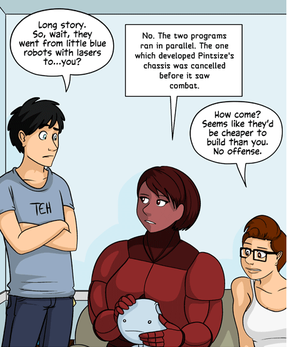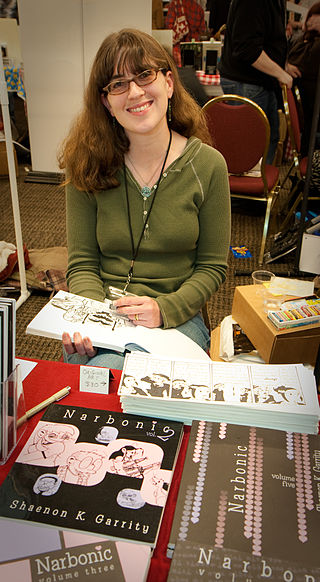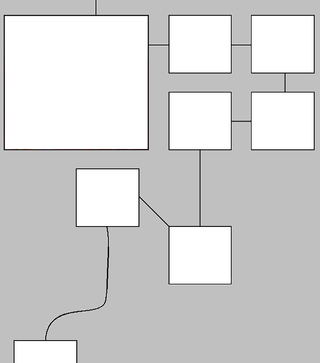This article needs additional citations for verification .(April 2024) |
A guest comic (or guest strip) is an issue of a comic strip that is created by a different person (or people) than usual. [1] The practice is especially common in webcomics.
This article needs additional citations for verification .(April 2024) |
A guest comic (or guest strip) is an issue of a comic strip that is created by a different person (or people) than usual. [1] The practice is especially common in webcomics.
Guest comics are usually requested of other artists by the usual creator of a webcomic. This may be done for a variety of reasons:
Guest comics are usually not meant to be canonical with the normal comic; their purpose is primarily entertainment.
Sometimes, guest comics are not published as if they were regular comics, but instead exhibited on the comic's website in a separate section; e.g. White Ninja Comics . Webcomic creators that are in the same webcomic syndicate (e.g. Dayfree Press) frequently do guest comics for each other, sometimes simultaneously.
A comic strip is a sequence of cartoons, arranged in interrelated panels to display brief humor or form a narrative, often serialized, with text in balloons and captions. Traditionally, throughout the 20th and into the 21st century, these have been published in newspapers and magazines, with daily horizontal strips printed in black-and-white in newspapers, while Sunday papers offered longer sequences in special color comics sections. With the advent of the internet, online comic strips began to appear as webcomics.
Webcomics are comics published on the internet, such as on a website or a mobile app. While many webcomics are published exclusively online, others are also published in magazines, newspapers, or comic books.

Questionable Content is a slice-of-life webcomic written and illustrated by Jeph Jacques. It was launched in August 2003 and reached its 5,000th comic in March 2023. The plot originally centered on Marten Reed, an indie rock fan; his anthropomorphized personal computer Pintsize; and his roommate, Faye Whitaker. However, over time Jacques has added a supporting cast of characters that includes employees of the local coffee shop, neighbors, and androids. QC's storytelling style combines romantic melodrama, situational comedy, and sexual humor, while considering questions of relationships, sexuality, dealing with emotional trauma, and artificial intelligence and futurism.

Shaenon K. Garrity is an American webcomic creator and science-fiction author best known for her webcomics Narbonic and Skin Horse. She collaborated with various artists to write webcomics for the Modern Tales-family of webcomic subscription services in the early 2000s, and write columns for various comics journals. Since 2003, Garrity has done freelance editing for Viz Media on various manga translations.

The infinite canvas is the feeling of available space for a webcomic on the World Wide Web relative to paper. The term was introduced by Scott McCloud in his 2000 book Reinventing Comics, which supposes a web page can grow as large as needed. This infinite canvas gives infinite storytelling features and creators more freedom in how they present their artwork.
The comic strip switcheroo was conducted on April 1, 1997, in which several cartoonists, without the foreknowledge of their editors, worked on the other's comic strip for that date, in commemoration of April Fools' Day.
Girlamatic was a webcomic subscription service launched by Joey Manley and Lea Hernandez in March 2003. It was the third online magazine Manley established as part of his Modern Tales family of websites. Girlamatic was created as a place where both female artists and readers could feel comfortable and featured a diverse mix of genres. When the site launched, the most recent webcomic pages and strips were free, and the website's archives were available by subscription. The editorial role was held by Hernandez from 2003 until 2006, when it was taken over by Arcana Jayne-creator Lisa Jonté, one of the site's original artists. In 2009, Girlamatic was relaunched as a free digital magazine, this time edited by Spades-creator Diana McQueen. The archives of the webcomics that ran on Girlamatic remained freely available until the website was discontinued in 2013.

Erotic comics are adult comics which focus substantially on nudity and sexual activity, either for their own sake or as a major story element. As such they are usually not permitted to be sold to legal minors. Like other genres of comics, they can consist of single panels, short comic strips, comic books, or graphic novels/albums. Although never a mainstream genre, they have existed as a niche alongside – but usually separate from – other genres of comics.
The history of comics has followed different paths in different parts of the world. It can be traced back to early precursors such as Trajan's Column, in Rome, Egyptian hieroglyphs and the Bayeux Tapestry.
Sluggy Freelance is a long-running webcomic written and drawn by Pete Abrams. Starting in 1997, it is one of the oldest successful webcomics, and as of 2012 had hundreds of thousands of readers. Abrams was one of the first comic artists successful enough to make a living from a webcomic.

Ctrl+Alt+Del (CAD) is a gaming-related webcomic and animated series written by Tim Buckley. The name of the comic refers to the Windows command Control-Alt-Delete. Premiering on October 23, 2002, the comic's focus has gradually shifted away from single strip gags towards longer story arcs and greater continuity through the use of video game references. Ctrl+Alt+Del currently is updated every Monday, Wednesday and Friday.
Comics has developed specialized terminology. Several attempts have been made to formalize and define the terminology of comics by authors such as Will Eisner, Scott McCloud, R. C. Harvey and Dylan Horrocks. Much of the terminology in English is under dispute, so this page will list and describe the most common terms used in comics.
The history of webcomics follows the advances of technology, art, and business of comics on the Internet. The first comics were shared through the Internet in the mid-1980s. Some early webcomics were derivatives from print comics, but when the World Wide Web became widely popular in the mid-1990s, more people started creating comics exclusively for this medium. By the year 2000, various webcomic creators were financially successful and webcomics became more artistically recognized.
Webcomics have grown in popularity in India since the early 2000s. Early webcomics created by Indian people were written and illustrated by people abroad and focused primarily on the differences in culture the creators experienced. Later webcomics put a strong emphasis on social and political issues present in the country, usually from a liberal perspective. Webcomics can reach large audiences in India when shared through social media.
The business of webcomics involves creators earning a living through their webcomic, often using a variety of revenue channels. Those channels may include selling merchandise such as t-shirts, jackets, sweatpants, hats, pins, stickers, and toys, based on their work. Some also choose to sell print versions or compilations of their webcomics. Many webcomic creators make use of online advertisements on their websites, and possibly even product placement deals with larger companies. Crowdfunding through websites such as Kickstarter and Patreon are also popular choices for sources of potential income.

Webcomics in France are usually referred to as either blog BD or BD numérique. Early webcomics in the late 1990s and early 2000s primarily took on the form of personal blogs, where amateur artists told stories through their drawings. The medium rose in popularity in economic viability in the country in the late 2000s and early 2010s. The Turbomedia format, where a webcomic is presented more alike a slideshow, was popularized in France in the early 2010s.

"Loss", sometimes referred to as "Loss.jpg", is a strip published on June 2, 2008, by Tim Buckley for his gaming-related webcomic Ctrl+Alt+Del. Set during a storyline in which the main character Ethan and his fiancée Lilah are expecting their first child, the strip—presented as a four-panel comic with no dialogue—shows Ethan entering a hospital, where he sees Lilah weeping in a hospital bed after suffering a miscarriage. Buckley cited events in his life as inspiration for the comic.
War and Peas is a webcomic by Elizabeth Pich and Jonathan Kunz.
Mr. Boop was a satirical webcomic created by Alec Robbins about a man married to Betty Boop. The comic launched on February 28, 2020. The comic comprises four 'books' made up of 217 strips.